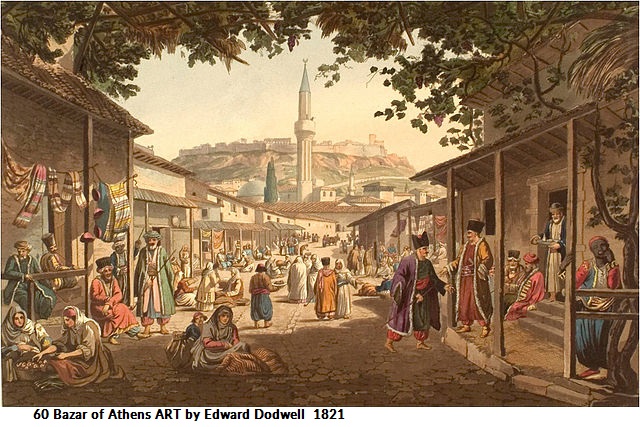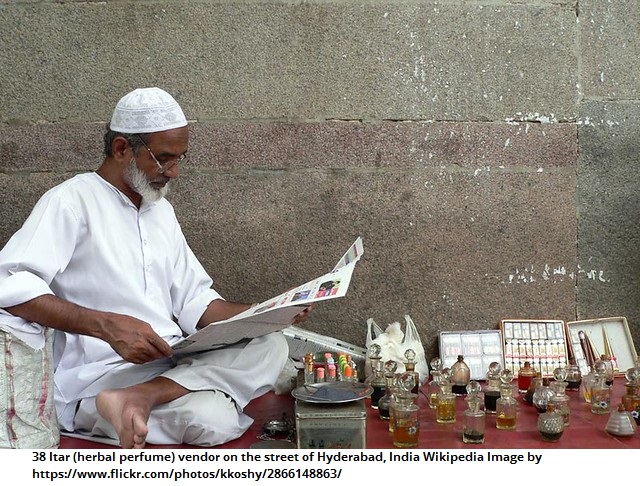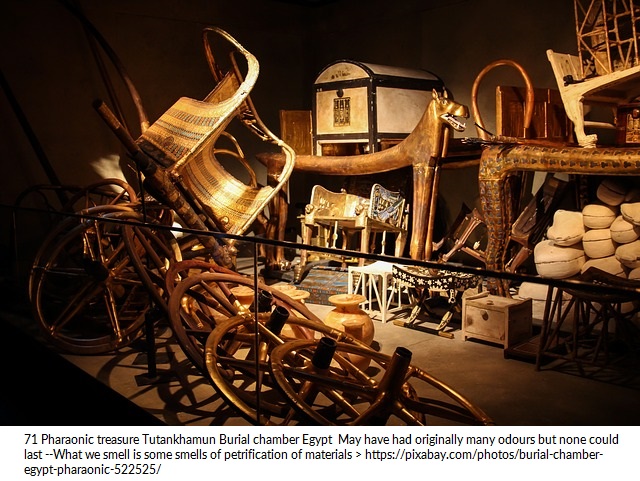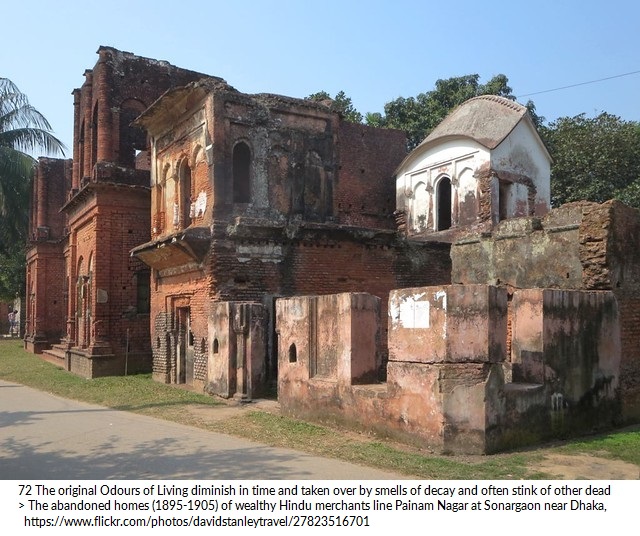Post 52 –by Gautam Shah
.
(Lecture series: Space Perception -Article-VII of 15)

‘Turn around a street corner and the smell changes because a new orientation has different visual and aural scale and airs movement. In many instances a different set of culture’ suggests itself. Cities offer “a rich melange of olfactory and other sensations”. Smell is an experience of living, and the nature, so represents a terrain-based location. ‘Smell is an intangible property of tangible heritage.’


A city has neighbourhoods, each with distinctive smell. The smell has cultural significance for a place, but has no history to denote. The distinction is ethnological through cultural, religious and other practices. Odours have strong compartmentalizing factor for a society. We easily sense the ethnic groups with a different diet, but to distinguish members of our own tribe, we have to rely on other means such as visual (body) and aural (speech-diction) features. (After- Urban Smell-scapes: Understanding and Designing City Smell Environments By Victoria Henshaw)

5th C BC Sophocles describes Thebes as ‘heavy with mingled burden of sounds and smells, of groans, hymns and incense’.
Nero’s Rome was full of stench of refuse rotting by the wayside, the piercing fragrance of burning myrrh from the temples, a heavy aroma of foods being cooked in the street, sweet seductive scents of flowering gardens, the mal-odour of rotting fish, sharp smell of urine from public latrines, and incense trail of passing procession -Aroma: The Cultural History of Smell.


On a typical day some 10,000 people would be present at Versailles estate. But there were hardly any toilets, not even for the aristocrats. And everyone, without exception to their position would occasionally ease themselves in courtyards, interior corners or under the stairs. Visitors complained about the awful stench that was omnipresent everywhere. Chamber pots overflowed and moisture seeped into the structure. It was visually a splendid palace, but a stinkiest one. Louis XIV put a new rule in place according to which the hallways were to be cleansed once every week. Orange trees’ cuttings were placed in vases to mask the smell.


The City of Paris had terrible sanitary conditions. There was no system for management of solid wastes and night soil waste. Servants emptied the pots out of the windows. In a city where water pipes were laid to enliven fountains, but not carry the sewage. Solid waste of repairs or demolition of buildings was simply spread out on the streets or public lands. Cities’ streets were full of ground dirt of debris, mixed with night soil and blood from slaughterhouses. Dirt, dung, food, and filth mix rose to ankle-deep levels. At places ground floors were buried and became cellar floors. It soiled the clothes so badly that no soap could remove the stain or stink of it. Kings dictate to clean up the city, asked the commissioners to carry away the debris, and dump it in the river Seine. Things were no different across towns across the world and till 1900s.

Place making has emerged as the central theme in Urban Design. It is ‘aimed at rediscovering, enhancing, protecting or creating locally significant place related meanings’. —Urban Smell scapes: Understanding and Designing City Smell Environments By Victoria Henshaw.

Our urban smell environment once comprised of open sewers, open heaps of garbage, animal excreta, meat-fish shops, slaughterhouses and factories near residential areas, diesel vehicles and exotic foods. The smells were intimately linked with the density of population, social and economic conditions of the community, distribution and proportion of open spaces and orientation and patterns of street layout and climate of the place. For these reasons, it is common to see connections drawn between unpleasant smells (the definition of which is also contentious) and poverty and specific ethnicity. Urban geographical isolation of communities through political machinations has the basis in smells and related social and religious prejudices.

The smell-based geography is more of visitors’ perception, local residents are smell habituated. Smell of a place is a unique brand for tourism. Other tangible heritage can be recorded and recreated, but smell of a place is variable and circumstantial, so unless the totality of living and environment are allowed to flourish, the smell will disappear.

Japanese Ministry for the Environment through a survey listed 100 most important smells of Japan (including ancient woods, sea breeze, sake distilleries and a street lined with bookshops) This was a cultural legacy ‘to be handed down to the children’.

The smell-knowledge of the past is odourless. We used to smell history in museums, but not in open to sky archeological sites. Museums, once allowed the smell of books, artefacts, because these were stored in open cases. It was realized that such smells emanate from the processes of decay, and so exhibits are now sealed in vacuum or gas.

In built spaces, we were, once able to simultaneously experience exterior and interior olfactory environments. For many children of late 20th C the exteriors were for the experience of ‘unused or pristine spaces’. The exteriors are now becoming vastly inter-connected or continuous spaces with controlled environments. New built structures offer some ‘freshness’ of the unused spaces.

The smell ‘habituation’ and smell personalization are aspects of occupation of interior spaces. New occupants change the interior furnishings and repaint the space to scour the effects of earlier occupation, and imprint it with odours of own lifestyles. The process is very similar to a conscious attempt of visual changes made to domesticate and personalize a home into a distinguished entity.

Smell is gradually being eliminated from our Urban living, with factory cooked foods, ventilation through tall ducts, air-filtering devices, better environmental controls and planning of public spaces and streets, in consideration of natural air movements, use of non-fossil fuels, preference for neutral odours in all consumer goods.
![]()
Smell neutral space of modern urban setting is not an exclusive process sensorial perception. Cities are losing the local spatial variations through equal architecture and equally bland environment. This is a continuing process. Night darkness of the middle ages towns were removed with street lighting as well as interior illumination through glazed windows and feebly lit architectural lanterns and steeples. Later the city noises of trams, trains and industry of late 19th C were removed. The cluttered city spaces have clean and well-articulated streets and public spaces. Sensorial subduing may regulate the tactility in living.

.
2 thoughts on “URBAN SMELLS”